上外版(2020)选择性必修第三册 Unit 4 Protecting the Environment Reading B 课件(16张PPT)
文档属性
| 名称 | 上外版(2020)选择性必修第三册 Unit 4 Protecting the Environment Reading B 课件(16张PPT) | 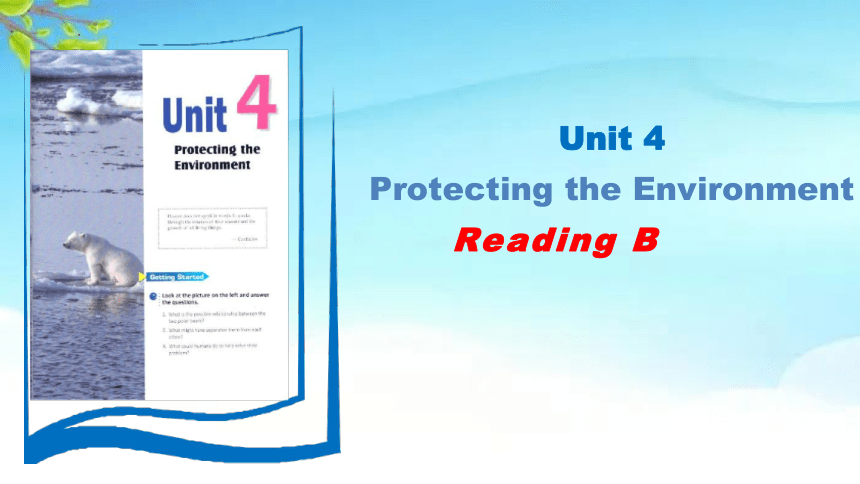 | |
| 格式 | pptx | ||
| 文件大小 | 10.5MB | ||
| 资源类型 | 教案 | ||
| 版本资源 | 上外版(2020) | ||
| 科目 | 英语 | ||
| 更新时间 | 2023-07-01 10:43:57 | ||
图片预览

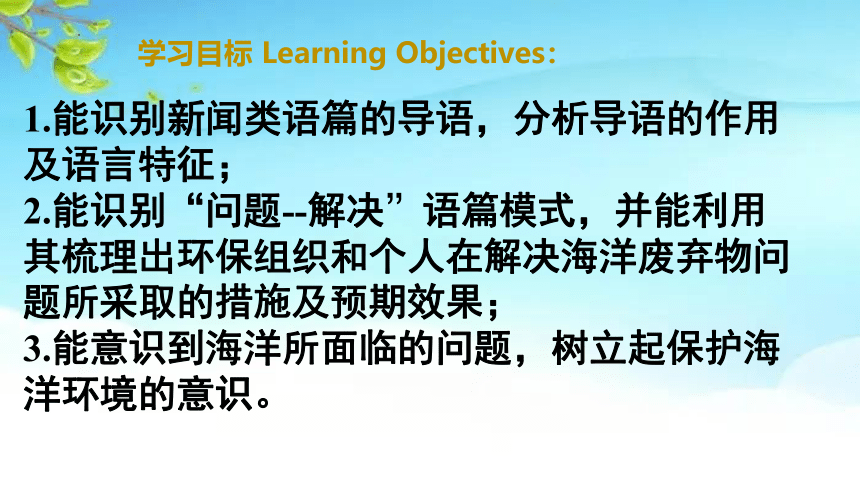
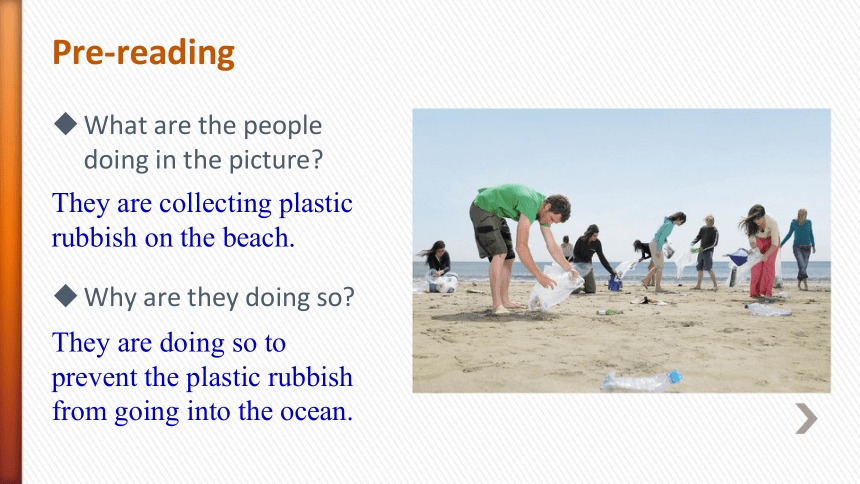
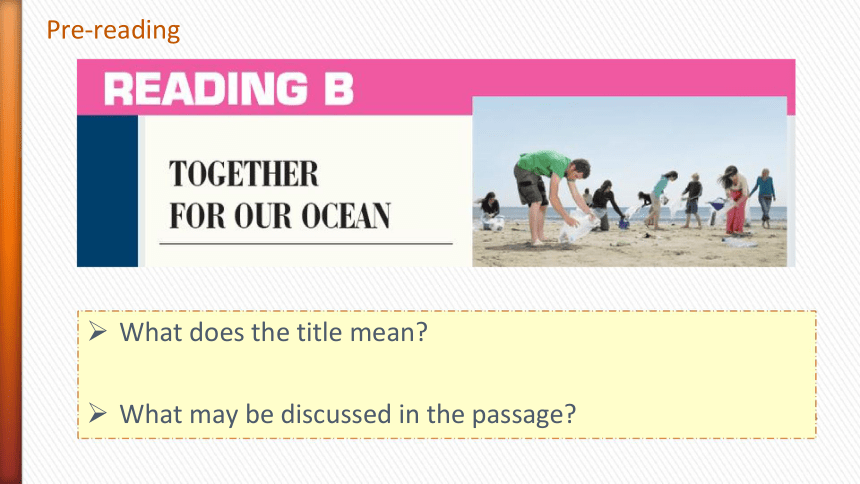
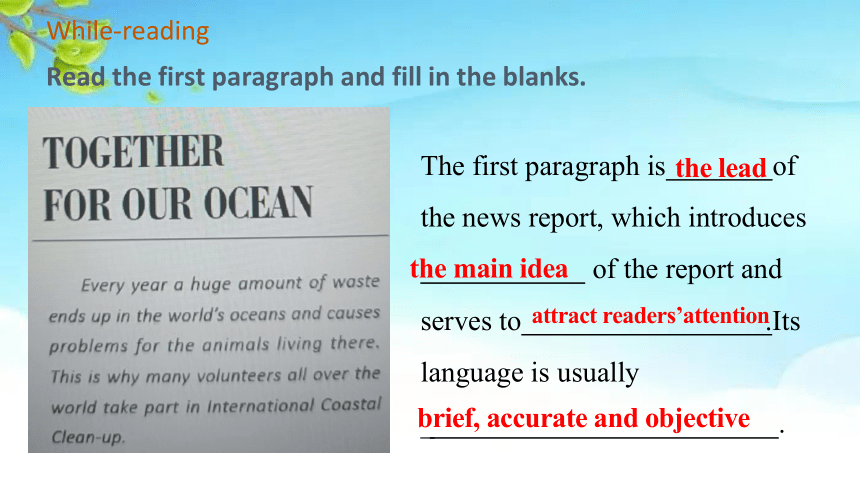

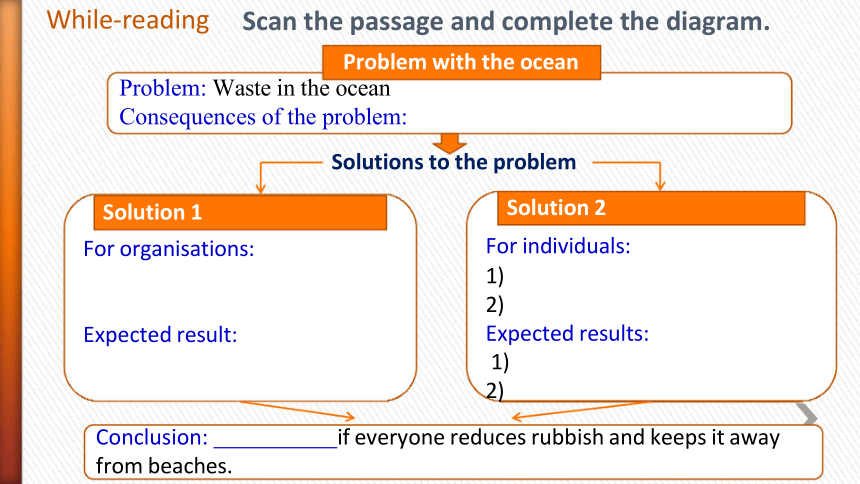
文档简介
(共16张PPT)
Unit 4
Protecting the Environment
Reading B
学习目标 Learning Objectives:
1.能识别新闻类语篇的导语,分析导语的作用及语言特征;
2.能识别“问题--解决”语篇模式,并能利用其梳理出环保组织和个人在解决海洋废弃物问题所采取的措施及预期效果;
3.能意识到海洋所面临的问题,树立起保护海洋环境的意识。
Pre-reading
What are the people doing in the picture
They are collecting plastic rubbish on the beach.
Why are they doing so
They are doing so to prevent the plastic rubbish from going into the ocean.
What does the title mean
What may be discussed in the passage
Pre-reading
While-reading
Read the first paragraph and fill in the blanks.
The first paragraph is of the news report, which introduces
of the report and serves to .Its language is usually
_ .
the lead
the main idea
attract readers’attention
brief, accurate and objective
Content
the lead
the
the
the
Paragraph Para.1
Para(s). 2 Para(s).3-5 Para(s).6
Skim the passage and find out its structure, textual pattern and main idea by filling the blanks.
The textual pattern:
The passage is mainly about:
problem-solution
the waste problem in the
ocean and the suggested solutions to the problem.
problems
solutions
conclusion
Scan the passage and complete the diagram.
While-reading
Problem with the ocean
Problem: Waste in the ocean Consequences of the problem:
Solutions to the problem
For organisations:
Expected result:
Solution 1
For individuals:
1)
2)
Expected results:
1)
2)
Solution 2
Conclusion: if everyone reduces rubbish and keeps it away from beaches.
While-reading
About 80% of all marine waste is plastic from bottles and packaging. This rubbish runs into rivers when it rains and then flows into the sea. Most of the rubbish sinks to the bottom of the ocean but some stays on the surface and collects in large areas like the Great Pacific Garbage Patch. The rest ends up on
beaches. Rubbish causes problems for the animals living in the
ocean. Some animals mistake rubbish for food. For example, some turtles living on jellyfish think that plastic bags are a type of food. The plastic can block their stomachs so that they starve, or it may poison the turtles. A survey by the University of Queensland showed that 50% of green turtles eat rubbish, and that figure is increasing. As six species of sea turtle are already threatened with extinction, this is a big problem.
Problem
Consequences
80%: plastic from bottles and packaging 20%: other waste
waste in the ocean
Problem: Waste in the ocean / Marine waste
Problem with the ocean
While-reading
Consequences of the problem:
Rubbish causes problems for the animals living in the ocean. / Some animals mistake rubbish for food.
sink to the bottom
stay on the surface and collect in large areas
end up on beaches
How does the writer illustrate the consequences
About 80% of all marine waste is plastic from bottles and packaging. This rubbish runs into rivers when it rains and then flows into the sea. Most of the rubbish sinks to the bottom of the ocean but some stays on the surface and collects in large areas like the Great Pacific Garbage Patch. The rest ends up on
beaches. Rubbish causes problems for the animals living in the
some turtles living on jellyfish think that plastic bags are a type of food. The plastic can block their stomachs so that they starve, or it may poison the turtles. A survey by the University of Queensland showed that 50% of green turtles eat rubbish, and that figure is increasing. As six species of sea turtle are
already threatened with extinction, this is a big problem.
While-reading
Problem
Consequences
giving examples
using statistics
ocean. Some afneiemdainlsgmonistake rubbish for food. For example,
are already in danger of dying out /
are already under the threat of extinction
threaten v. to be a danger to sth
threaten …with… / be threatened with
→n. threat under threat /under the threat of…
While-reading
With millions and millions of tons of waste entering the ocean every year, it is clear that we need to do something to protect the animals living there. One organisation that does this is Ocean Conservancy, an organisation that started in the USA...
water
water cycle, helping to provide the we drink.” By
cleaning up rubbish you are protecting the ocean environment and the animals that live there.
Solution 1
For organisations:
Organisations like Ocean Conservancy have organised International Coastal Clean-up.
Expected result:
By cleaning up rubbish you are protecting the ocean environment and the animals that live there.
So why is it so important to clekaeneupps sobuar loivceeans Ocean Conservancy is clear about this. On their website you can read: “The ocean sustains us with the basic elements of life — it produces half of the oxygen in the air we breathe, and it is an essential part of the
Solution 1
While-reading
What can each and every one of us do about that rubbish in the oceans
Perhaps the most important thing is
that you can think about how much packaging i s i ncluded with th e products you buy, and where you throw away any rubbish you have. Less
packaging and fewer products are a step on the way to more sustainable development. You can also take part in
ocean clean- up day. I f rubbish is
picked up from the beach, it will not
f low out to the ocean and cause
problems for animals that eat it or
become trapped in it.
Solution 2
For individuals:
Individuals should use less packaging and pay attention to where they throw away the rubbish.
Individuals can also take part in ocean clean-up day.
Expected results:
Less packaging and fewer products are a step on the way to more sustainable development.
If rubbish is picked up from the beach, it will not flow out to the ocean and cause problems for animals that eat it or become trapped in it.
keep sb in a dangerous place or
bad situation that they want to
get out of but cannot
Solution 2
While-reading
Cleaning up the oceans seems like an impossible task, but if everybody reduces the amount of rubbish they produce, and keeps rubbish off the beaches, one day there may no longer be a need for ocean clean-up day.
Conclusion:
if everyone reduces rubbish and keeps it away from beaches.
There will be no need for ocean clean-up day in the future
Post-reading
Group discussion:
Can you think of other solutions to settle the issue List the solutions and expected results in the table.
Solutions Expected results
Homework:
Read the passage of Reading B aloud.
Give an oral account of the waste p ro b l e m i n t h e o c e a n logically based on the diagram in the textbook.
T h a n k
y o u !
Unit 4
Protecting the Environment
Reading B
学习目标 Learning Objectives:
1.能识别新闻类语篇的导语,分析导语的作用及语言特征;
2.能识别“问题--解决”语篇模式,并能利用其梳理出环保组织和个人在解决海洋废弃物问题所采取的措施及预期效果;
3.能意识到海洋所面临的问题,树立起保护海洋环境的意识。
Pre-reading
What are the people doing in the picture
They are collecting plastic rubbish on the beach.
Why are they doing so
They are doing so to prevent the plastic rubbish from going into the ocean.
What does the title mean
What may be discussed in the passage
Pre-reading
While-reading
Read the first paragraph and fill in the blanks.
The first paragraph is of the news report, which introduces
of the report and serves to .Its language is usually
_ .
the lead
the main idea
attract readers’attention
brief, accurate and objective
Content
the lead
the
the
the
Paragraph Para.1
Para(s). 2 Para(s).3-5 Para(s).6
Skim the passage and find out its structure, textual pattern and main idea by filling the blanks.
The textual pattern:
The passage is mainly about:
problem-solution
the waste problem in the
ocean and the suggested solutions to the problem.
problems
solutions
conclusion
Scan the passage and complete the diagram.
While-reading
Problem with the ocean
Problem: Waste in the ocean Consequences of the problem:
Solutions to the problem
For organisations:
Expected result:
Solution 1
For individuals:
1)
2)
Expected results:
1)
2)
Solution 2
Conclusion: if everyone reduces rubbish and keeps it away from beaches.
While-reading
About 80% of all marine waste is plastic from bottles and packaging. This rubbish runs into rivers when it rains and then flows into the sea. Most of the rubbish sinks to the bottom of the ocean but some stays on the surface and collects in large areas like the Great Pacific Garbage Patch. The rest ends up on
beaches. Rubbish causes problems for the animals living in the
ocean. Some animals mistake rubbish for food. For example, some turtles living on jellyfish think that plastic bags are a type of food. The plastic can block their stomachs so that they starve, or it may poison the turtles. A survey by the University of Queensland showed that 50% of green turtles eat rubbish, and that figure is increasing. As six species of sea turtle are already threatened with extinction, this is a big problem.
Problem
Consequences
80%: plastic from bottles and packaging 20%: other waste
waste in the ocean
Problem: Waste in the ocean / Marine waste
Problem with the ocean
While-reading
Consequences of the problem:
Rubbish causes problems for the animals living in the ocean. / Some animals mistake rubbish for food.
sink to the bottom
stay on the surface and collect in large areas
end up on beaches
How does the writer illustrate the consequences
About 80% of all marine waste is plastic from bottles and packaging. This rubbish runs into rivers when it rains and then flows into the sea. Most of the rubbish sinks to the bottom of the ocean but some stays on the surface and collects in large areas like the Great Pacific Garbage Patch. The rest ends up on
beaches. Rubbish causes problems for the animals living in the
some turtles living on jellyfish think that plastic bags are a type of food. The plastic can block their stomachs so that they starve, or it may poison the turtles. A survey by the University of Queensland showed that 50% of green turtles eat rubbish, and that figure is increasing. As six species of sea turtle are
already threatened with extinction, this is a big problem.
While-reading
Problem
Consequences
giving examples
using statistics
ocean. Some afneiemdainlsgmonistake rubbish for food. For example,
are already in danger of dying out /
are already under the threat of extinction
threaten v. to be a danger to sth
threaten …with… / be threatened with
→n. threat under threat /under the threat of…
While-reading
With millions and millions of tons of waste entering the ocean every year, it is clear that we need to do something to protect the animals living there. One organisation that does this is Ocean Conservancy, an organisation that started in the USA...
water
water cycle, helping to provide the we drink.” By
cleaning up rubbish you are protecting the ocean environment and the animals that live there.
Solution 1
For organisations:
Organisations like Ocean Conservancy have organised International Coastal Clean-up.
Expected result:
By cleaning up rubbish you are protecting the ocean environment and the animals that live there.
So why is it so important to clekaeneupps sobuar loivceeans Ocean Conservancy is clear about this. On their website you can read: “The ocean sustains us with the basic elements of life — it produces half of the oxygen in the air we breathe, and it is an essential part of the
Solution 1
While-reading
What can each and every one of us do about that rubbish in the oceans
Perhaps the most important thing is
that you can think about how much packaging i s i ncluded with th e products you buy, and where you throw away any rubbish you have. Less
packaging and fewer products are a step on the way to more sustainable development. You can also take part in
ocean clean- up day. I f rubbish is
picked up from the beach, it will not
f low out to the ocean and cause
problems for animals that eat it or
become trapped in it.
Solution 2
For individuals:
Individuals should use less packaging and pay attention to where they throw away the rubbish.
Individuals can also take part in ocean clean-up day.
Expected results:
Less packaging and fewer products are a step on the way to more sustainable development.
If rubbish is picked up from the beach, it will not flow out to the ocean and cause problems for animals that eat it or become trapped in it.
keep sb in a dangerous place or
bad situation that they want to
get out of but cannot
Solution 2
While-reading
Cleaning up the oceans seems like an impossible task, but if everybody reduces the amount of rubbish they produce, and keeps rubbish off the beaches, one day there may no longer be a need for ocean clean-up day.
Conclusion:
if everyone reduces rubbish and keeps it away from beaches.
There will be no need for ocean clean-up day in the future
Post-reading
Group discussion:
Can you think of other solutions to settle the issue List the solutions and expected results in the table.
Solutions Expected results
Homework:
Read the passage of Reading B aloud.
Give an oral account of the waste p ro b l e m i n t h e o c e a n logically based on the diagram in the textbook.
T h a n k
y o u !
同课章节目录
